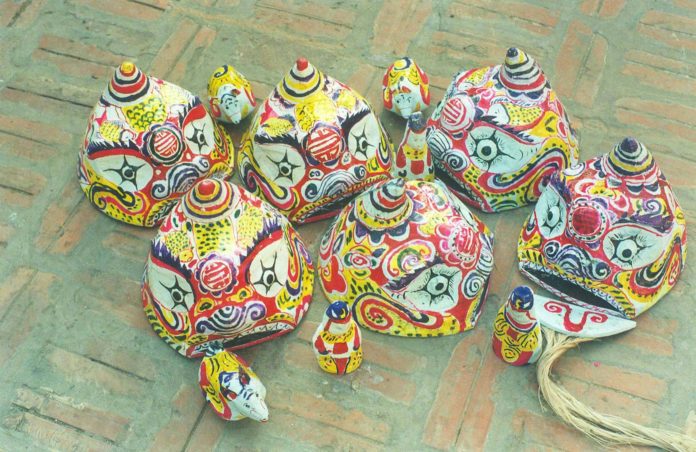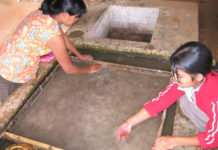Dó paper is made from the bark of the Rhamnoneuron blansae tree. In ancient times, Vietnamese people wrote with quills on dó paper, so there were many villages making the dó paper, focusing mostly in West Lake, Hanoi. Because of the convenience of industrial paper, dó paper has been used less often. Nowadays, only Duong O Village, Bac Ninh can maintain the craft.
 Dó trees are planted in the mountainous areas and the diameter of the tree is around 4-8 cm wide. First, the bark peels off the tree and is soaked in the water to make it softer. Then it is baked in a pot with limestone until very tender and then the lime is washed off. The dó bark is once again peeled off, and only the softer bark inside is used. The bark is ground into powder with a mortar or a small grinder, removing impurities. The powder dó is then put into a water tank, stirred aggressively in order to dissolve in the water, and mixed with a resin to increase the attachability.
Dó trees are planted in the mountainous areas and the diameter of the tree is around 4-8 cm wide. First, the bark peels off the tree and is soaked in the water to make it softer. Then it is baked in a pot with limestone until very tender and then the lime is washed off. The dó bark is once again peeled off, and only the softer bark inside is used. The bark is ground into powder with a mortar or a small grinder, removing impurities. The powder dó is then put into a water tank, stirred aggressively in order to dissolve in the water, and mixed with a resin to increase the attachability.
Paper tray is a wooden frame with a thin and smooth blind on top. The tray is filled with dó powder and shaken gentle to settle. The blind is then removed in order to take the paper out. The technique is important. The craftsperson carefully checks with his or her right hand to make sure the paper is thinned out finely. Afterwards, the whole stack of paper will be drained out, then pasted on the wall so that they can be dried out completely. Many places fire the wall to dry the papers more quickly.
Nowadays, dó paper is used to be painted, printed with traditional painting, or be made as kids’ toys, made as gift wrap paper. Foreigners usually enjoy writing on the dó paper material. To print the traditional paintings, Dong Ho villagers will create a light colour layer, then a layer the colour of shell to create a sparkling effect for the paintings. Then they will use the woodblock to print the painting, each colour on the painting is a block and separate layer of printing. Dó painting has many layers, making the colours on the paintings very vibrant.
Dó paper is applied to make masks, lion or other animal hats. When dampened, the paper is easily stretched out to cover fully the frame without being torn off. Dó paper is also used to print as votive money because it is easily burned and makes less ash. Recently, some companies printed the documents on dó paper because its durability comparing with industrial paper will help maintain the documents better.





